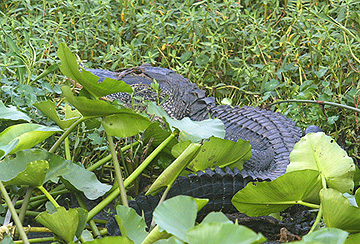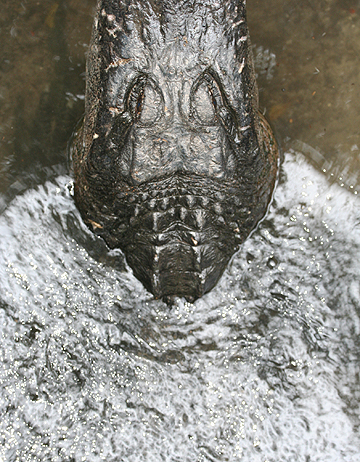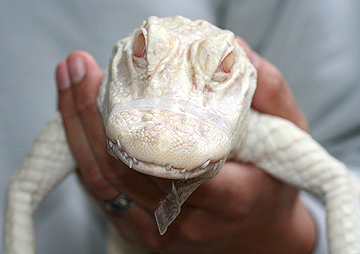
Alligator Island: A lone alligator in Withlacoochee Bay on Florida’s west coast is on the hunt for food. Digital camera, flash fill, 180 mm lens.
Photographer Jim Austin, M.A. A.C.E, is your Gator Guide on this wild Apogee Adventure with a pinnacle predator…
By the mouth of the Withlacoochee River on Florida’s west coast, I crouched on the bottom step of our boat to be at eye level with the American Alligator, just 30 feet away. As I tripped the shutter, the gator’s eyes caught the flash burst. The alligator just floated. He did not seem to blink. The photograph, titled “Alligator Island,” shows a view of a reptile perfectly adapted to its brackish water home: an island unto itself.
On a second adventure, morning mist rose from Florida’s Suwannee River as I spied the large American Alligator targeting his gaze my way. I put the camera to my eye, and he began to roll about on the river bank. Click. He kept thrashing as our boat got closer, and then, as the sun came out, he gave me his best American Alligator glare. Click, click. It was stunning to see, and photograph, this wild gator crushing lily pads with his 900 pound body.
To photograph wild or captive alligators you have to ask yourself two questions. First, where can I find alligators to take pictures of their behavior? Second, how can I photograph without putting either myself or the alligator in danger?
Where Gators Growl

Way Down Upon the S’wannee River: An American Alligator bathing in the lily pads on the river bank, photographed from over 50 feet away. Canon D30, 180mm lens.
Florida’s immense coastline, wild rivers, and lakes offer picturesque opportunities to photograph American Alligators. There are thought to be 1 to 2 million of them statewide.
My top 4 favorite alligator spotting locations are: the Everglades, the wild rivers of the Florida Panhandle, Lake Jesup, and the commercial St. Augustine Alligator Farm.
While making images in the wild is part of the adventure, the Alligator Farm lets you make images safely from its well-designed elevated walkways. I walked on one above a male American Alligator. First, he lifted his head and front legs out of the water. Then, putting his chest back in the water, he bellowed while partially submerged. The vibrating water carried his deep growling calls that advertised his presence to females in the area, and warned away other males.
By the way, the St. Augustine Alligator Farm also has the largest salt water crocodile in captivity, “Maximo.” The view of this 15 foot 3 inch reptile from his underwater viewing room takes your breath away, and by itself is well worth the admission price. An award-winning, 60- second film where all 25 species of crocodiles and alligators gape, crawl and finally morph into each other is downloadable on their website ( http://www.alligatorfarm.com ).
To visit the Alligator Farm, go to St. Augustine, south of Jacksonville on Highway A1A. It’s open 7 days a week. By walking along their safe boardwalks, you will be up close and personal with the reptiles. As a result you can photograph them with short focal length lenses. The image above was made with a 70-200mm zoom.

Growling Gator: Water vibrates around his chest and carries this alligators low rumbling call. To me this booming loud and low call sounded like a male lion.

This youngster had a creamy white, dry skin. His mouth, taped by his Alligator Farm caretaker, held a growing set of small pointy teeth.
Alligator Photo Tips for Beginners:
1. Think safety. In the presence of an alligator, safety is the first priority. Stay at least 30 feet away. Why? Alligators can clock running bursts of 30 miles per hour and when they snap at prey this motion is so fast, slow motion filming is needed to view it. Alligators are predators at the top of the food chain, known as pinnacle predators. You don’t want to be dinner.
2.Study alligator behavior. For example, if you already know that alligators “headslap,” you can wait to get a specific shot of that behavior. Research shows that only male gators headslap, and dominant males headslap more often than those further down in the rank order. Perhaps they slap their heads on the water to show one another who is the boss.
3.Photograph from a boat. I learned to photograph alligators from a boat with a deck five feet above the waterline, which eliminated the possibility of an alligator climbing on board, and gave me a stable platform for a tripod. It was less risky to take a boat slowly towards the gator, rather than having a gator approach me. Approach alligators with stealth; move slowly, keep your distance, do not carry food, and remain quiet and still.
4.The eyes have it. To ensure the eyes are in focus, train the point of focus of your lens on the snout just in front of the eyes. If you are using a telephoto lens, like 200 or 300 mm, make sure your aperture is at least F/5.6 to F/8 for adequate depth of field. To capture the expression on an alligators face, lower the camera as close to the alligator’s eye level as safety allows.

Leave a Reply